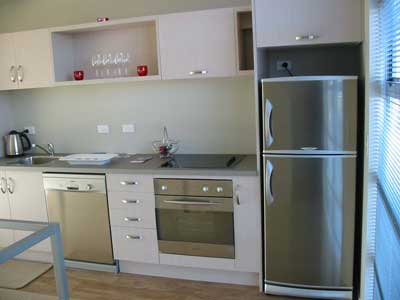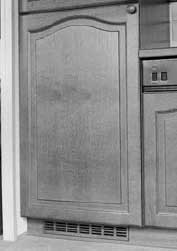Kitchen Refrigerator Freezer Storage Appliances – Kitchen Design Considerations Ideas
The two most common storage appliances in the kitchen are the refrigerator and the freezer. Both are 19th century inventions, which a number of worldwide companies built their fortunes on. Kitchen refrigerator freezer design considerations are vast and will be explained in detail, I bet you will learn something new from this page.
Simply explained, a refrigerator or freezer works by removing the heat from the food and dispensing that heat outside of the storage areas.
It does this by compressing and uncompressing a gas that is circulated in the cooling compartment inside tubes. The gas when compressed goes very very cold and absorbs the heat and then when it is pushed to the outside of the cooling compartment is allowed to un compress.
This allows the gas to warm up and the heat trapped in it to dissipate.
The gas then travels along the tubes to be compressed (that’s the humming sound you will often here from refrigerators compressor or pump) and this compressed gas is then passed through the tubes to the interior of the refrigerator or freezer to once again absorb the heat and in turn be uncompressed outside the cooling compartment.
That’s the basic principal anyway. With modern fridge freezers there are all sorts of electronic controls and warmer and colder areas within the appliance for butter, ice and chilled water etc but that’s enough information about the workings of the unit.
(Incidentally the same principal is applied to heat pumps or air-conditioning units).
The reason for having this knowledge as a designer, is that these appliances give off continuous amounts of heat when in use and this has to be considered when designing space for the appliance. They need to be ventilated if they are to be efficient and it helps with maintaining a constant temperature in the kitchen if this element is considered.
|
Ventilated and integrated refrigerator with integrated dishwasher beside, in this kitchen.
|
An example of a ventilation grille. |
|
An example of a ventilation grille. |
With refrigerated storage what else do we have to consider? How much space do we need and how much space do we have are the main criteria. The more refrigerated space you have may mean the less pantry storage space you need. Storage space is measured in cubic feet or liters and we work that out by multiplying the internal width, height and depth.
But how much is enough? Usually there is never enough with a growing family and the additional storage space that you have negates the necessity of too frequent grocery shopping. However for a single person its easy to have an abundance of storage that you wont necessarily use. Many families and single people alike keep a day to day use refrigerator and have an additional chest storage freezer somewhere else such as hiding in the garage’, laundry, utility room or a large pantry. When planning your kitchen allow for the added freezer at a later stage even if you don’t consider it necessary now. Families grow and houses change hands. You always add value to the home with additional storage space or space for the essential kitchen storage appliances.
When choosing the type of fridge or freezer consider the following:
The climate you live in.
The warmer the climate the more you may rely on the appliance to keep food fresh.
What sort of meals or foods you are likely to be eating.
For example a vegetarian based diet versus those that enjoy meats or the combination, vegetarians do not need to freeze meat and generally speaking eat more fresh food, so the refrigerator is more important space wise than the freezer. We most certainly are not the same and you as the designer should be aware of this when giving advice.Excellence in design is not forcing your ideas or your tastes on them but working out what your client enjoys or the lifestyle they follow and finding the most appropriate solution.
Some meats can be frozen and so can many vegetables but is that the way the user lives. Do they prefer the food to be as fresh as possible without being frozen, is the refrigerator accessed every hour as in some large families, how powerful is the ability of the fridge to cool things quickly if being opened constantly are there many compartments in the fridge for storing cooked and raw items. All these and more are questions that you should be asking when considering the appliance for yourself or the client.
Another reason for using a large freezer is economy. Buying a large freezer and then buying foods in bulk whenthey are on special or sale can save a great deal of money over a year to the point where it pays for the appliance itself. The following years are all money in the bank!
What other considerations are there?
How ergonomic is the appliance? Is the day freezer at the top of the appliance or at the bottom? Really it should be at the bottom as the cooling area of the fridge is more likely to be used frequently than the freezer so it make sense that the ability to access without bending should go to the area that gets used the most. However the other school of thought is that frozen foods are often heavy pieces of meat and cumbersome when frozen solid so perhaps its better to have the freezer area up high so that those items are easier to access.
When deciding this point, focus on who is using the appliance? Is the person old and perhaps a little frail or young fit and full of energy?
While we discuss the ergonomics of the fridge or freezers position and levels we should also consider the storage areas within and the handles to the fridge. Are they easily gripped? Will the drawers slide easily when full? How difficult is it to remove the shelves and drawers for cleaning. Are the plastics able to take the punishment of many people using the appliance frequently e.g. a teenage family? Most modern appliances are robust and have had these factors considered and designed into them but some are better than others and good design will have catered for this. Make a list of the points and check it out.
Choosing the Look of the Refrigerator or Freezer

All stainless steel appliances matching in this small apartment kitchen.
Now we have considered the practical points about the appliance we get to do the fun part which is choosing the look.
Is the appliance aesthetically pleasing?
Of course design is subjective but particular themes will work better than others. The ideal in my opinion is to have the front doors of the fridge integrated into the look of the cabinetry, however this may not be appropriate in the space you have for practical or budgetary reasons. Modern refrigerators come in almost any color from the traditional and sanitary looking white to stainless steel or hot Red. Smeg is one of the companies producing fridges in the old retro style if that is your theme.
Should the appliance not be integrated then it is very likely that you should try and match all your kitchen appliances in the same finish, i.e. stainless steel or colored for the dishwasher, microwave oven, oven and hob as well. All these items are on view all the time and have large vertical surfaces which makes there presence quite dominant in the room. Use them as a feature or hide them by integrating. Try not to mix and match unless that is the intent of the scheme. (i.e. pop art colors).
Note: Integrating means that the front of the appliance has a panel fixed to it to match the kitchen cabinetry.




